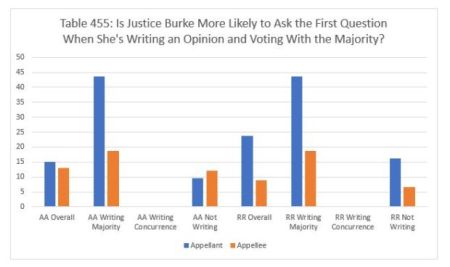Yesterday, we analyzed the data from nine years' worth of oral arguments in civil cases, looking at correlations between Justice Burke's question patterns, her voting and whether she wrote an opinion in a given case. Today, we address whether Justice Burke is statistically more likely to be writing an opinion in cases where she asks the first question of either side.
We begin with cases where Justice Burke voted with the majority to affirm. Overall, in 15% of such cases, she asked the first question to the appellant, and led off questioning to the appellee 13% of the time. Writing had a dramatic effect, at least as far as the appellant was concerned. In affirmances where Justice Burke wrote the majority opinion, the likelihood she would begin the questioning of the appellant was 43.75%. The effect on appellees was only marginal – she began the questioning of appellees in 18.75% of cases where she wrote the majority. Justice Burke was comparatively unlikely to ask the first question when she was not writing – 9.64% of the time for appellants, 12.05% for appellees.
In cases where Justice Burke joined a majority reversing, she began questioning of the appellants 23.67% of the time, but of appellees only 8.88%. Again, writing had a considerable impact. In cases where she wrote the majority, she began questioning of appellants 43.75% of the time, and of appellees 18.75%. When Justice Burke was not writing, she began with appellants 16.3% of the time, and with appellees in 6.67%.

There are few cases where Justice Burke began the questioning, but ultimately voted with the minority. Where she was in the minority of an affirmance, she began questioning of appellants 10% of the time overall, but in 16.67% of cases where she wrote a dissent. In cases where Justice Burke was in the minority of a dissent, she began questioning of appellants half the time.

Join us back here next Tuesday as we address Justice Burke's question patterns in criminal and quasi-criminal cases.
The content of this article is intended to provide a general guide to the subject matter. Specialist advice should be sought about your specific circumstances.


